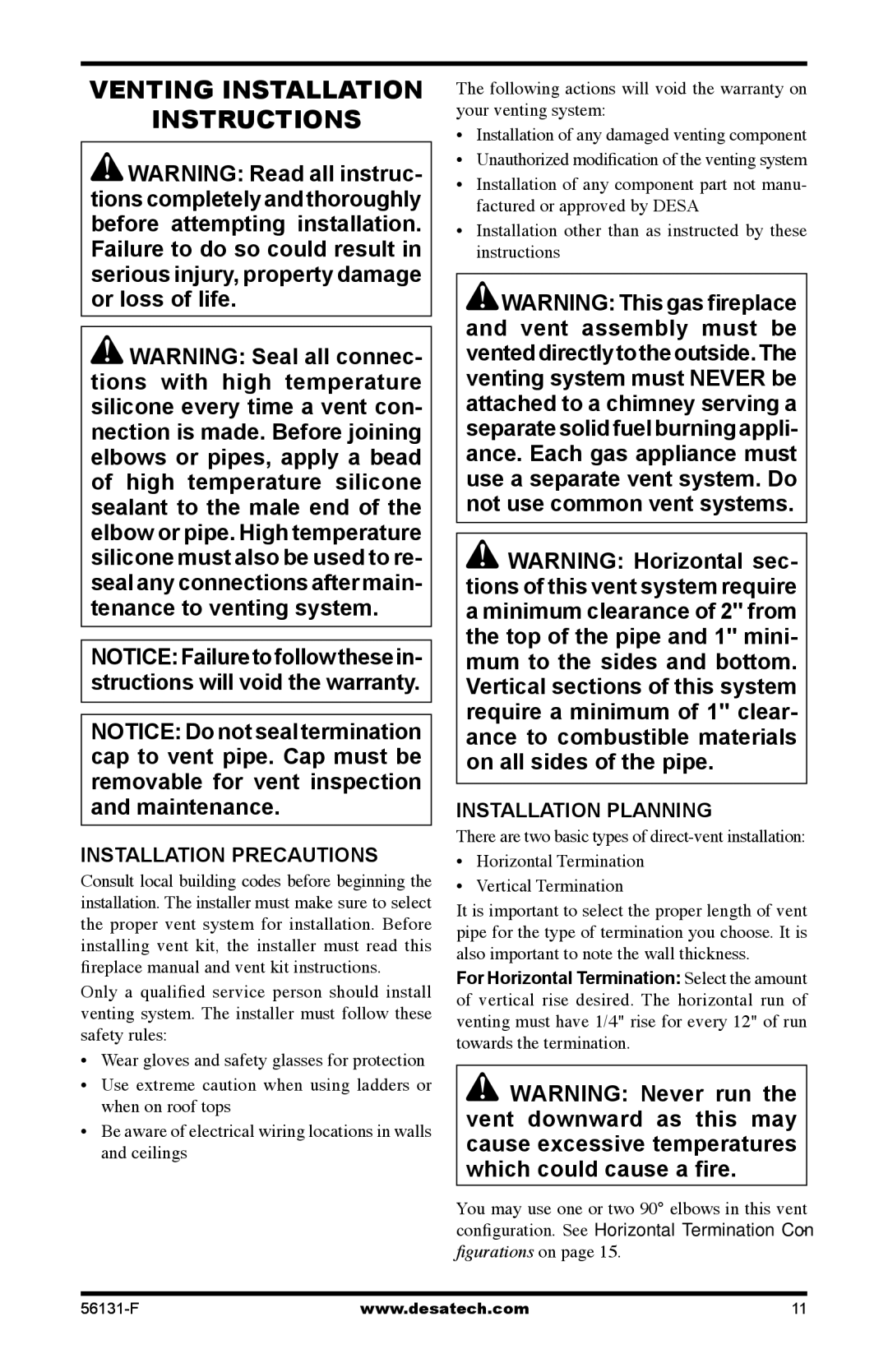
Venting Installation
Instructions
![]() WARNING: Read all instruc- tions completely and thoroughly before attempting installation. Failure to do so could result in serious injury, property damage or loss of life.
WARNING: Read all instruc- tions completely and thoroughly before attempting installation. Failure to do so could result in serious injury, property damage or loss of life.
![]() WARNING: Seal all connec- tions with high temperature silicone every time a vent con- nection is made. Before joining elbows or pipes, apply a bead of high temperature silicone sealant to the male end of the elbow or pipe. High temperature silicone must also be used to re- seal any connections after main- tenance to venting system.
WARNING: Seal all connec- tions with high temperature silicone every time a vent con- nection is made. Before joining elbows or pipes, apply a bead of high temperature silicone sealant to the male end of the elbow or pipe. High temperature silicone must also be used to re- seal any connections after main- tenance to venting system.
NOTICE:Failuretofollowthesein- structions will void the warranty.
NOTICE: Do not seal termination cap to vent pipe. Cap must be removable for vent inspection and maintenance.
Installation Precautions
Consult local building codes before beginning the installation. The installer must make sure to select the proper vent system for installation. Before installing vent kit, the installer must read this fireplace manual and vent kit instructions.
Only a qualified service person should install venting system. The installer must follow these safety rules:
•Wear gloves and safety glasses for protection
•Use extreme caution when using ladders or when on roof tops
•Be aware of electrical wiring locations in walls and ceilings
The following actions will void the warranty on your venting system:
•Installation of any damaged venting component
•Unauthorized modification of the venting system
•Installation of any component part not manu- factured or approved by DESA
•Installation other than as instructed by these instructions
![]() WARNING: This gas fireplace and vent assembly must be venteddirectlytotheoutside.The venting system must NEVER be attached to a chimney serving a separate solid fuel burning appli- ance. Each gas appliance must use a separate vent system. Do not use common vent systems.
WARNING: This gas fireplace and vent assembly must be venteddirectlytotheoutside.The venting system must NEVER be attached to a chimney serving a separate solid fuel burning appli- ance. Each gas appliance must use a separate vent system. Do not use common vent systems.
![]() WARNING: Horizontal sec- tions of this vent system require a minimum clearance of 2" from the top of the pipe and 1" mini- mum to the sides and bottom. Vertical sections of this system require a minimum of 1" clear- ance to combustible materials on all sides of the pipe.
WARNING: Horizontal sec- tions of this vent system require a minimum clearance of 2" from the top of the pipe and 1" mini- mum to the sides and bottom. Vertical sections of this system require a minimum of 1" clear- ance to combustible materials on all sides of the pipe.
INSTALLATION PLANNING
There are two basic types of
•Horizontal Termination
•Vertical Termination
It is important to select the proper length of vent pipe for the type of termination you choose. It is also important to note the wall thickness.
For Horizontal Termination: Select the amount of vertical rise desired. The horizontal run of venting must have 1/4" rise for every 12" of run towards the termination.
![]() WARNING: Never run the vent downward as this may cause excessive temperatures which could cause a fire.
WARNING: Never run the vent downward as this may cause excessive temperatures which could cause a fire.
You may use one or two 90° elbows in this vent configuration. See Horizontal Termination Con- figurations on page 15.
www.desatech.com | 11 |
